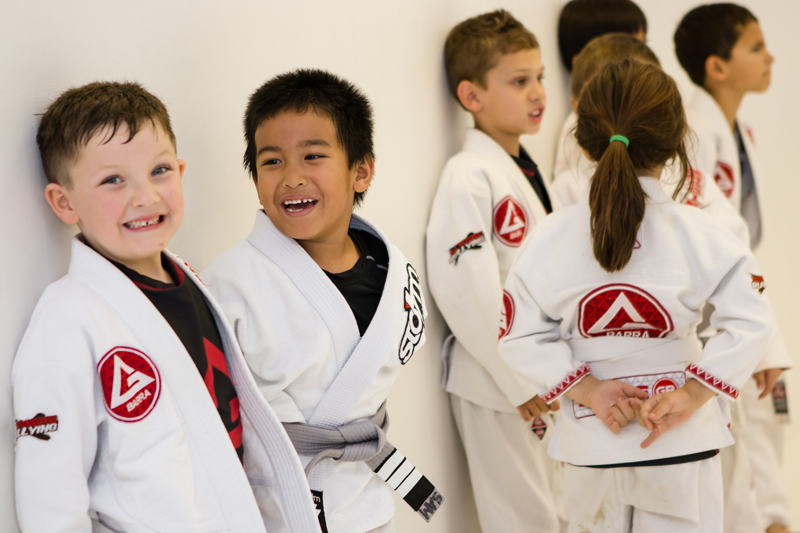This is something parents will often research the most beneficial style when looking for a martial art to enroll their kids in. The answer can be very long, especially when trying to consider all the benefits other martial arts bring. The simplest way for us to answer this question without overgeneralizing can be done by looking at two areas of our training: the practical application and live sparring part of our classes.
The first area I would like to bring a parent’s attention to is the actual efficiency and real life application of self-defense benefit they are looking for. Since Jiu Jitsu was first designed as a self-defense art, it satisfies the majority of parents who are concerned about preparing their child to be safe in real world situations. Although other martial arts traditionally offer important basic concepts of striking, good stance, and other self-defense, a couple things you may notice immediately in a Karate or Tae Kwon Do class (not all) is the practice of a stance where the martial artist’s hands are down by his side and often not protecting his head. The problem here is all fighters are aware that having your hands down by your hips not protecting your head is very dangerous, especially in a self-defense situation. This, among other training methods employed by many other martial arts, although important in teaching discipline and coordination, may not translate to a real scenario and does not simulate a real-life self-defense scenario. Grappling and ground fighting is a core element of our martial art, however when teaching self-defense scenarios, protecting the head, avoiding strikes and basic safety rules when dealing with an attacker are not overlooked at our school.
On the subject of self-defense, it is also critical that you train to adapt to any situation. Striking arts like Karate, Tae Kwon Do, and even more conventional ones like boxing often operate at an ideal striking distance. If you are too far to punch or too close to kick, you may have to move and use good footwork before you can use any technique. In Jiu Jitsu, there is a technique that can be used for nearly any situation to either avoid harm or advance your own position. This flexibility and enormous library of techniques also better prepares students for worst case scenarios than any other martial art. Even worse, most of these striking arts completely ignore ground techniques which is where any self-defense scenario eventually ends up barring an instant knockout. At times like this, you need to rely on an art like Jiu Jitsu which addresses threats in any position, at any range, standing or on the ground.
Not even other grappling disciplines like wrestling or judo have consistent, energy efficient answers for a strong athletic opponent standing over you raining down strikes or sinking their arm around your neck for a choke. Not only are there a variety of Jiu Jitsu techniques that can be used to avoid and escape these dangerous situations, but can often show you how to reverse the position entirely through technique and leverage. When it comes to self-defense scenarios on the street, it is always better to be prepared for any opponent, any situation, any time rather than hoping your opponent plays your game.
Every training session in Brazilian Jiu Jitsu typically consists of rigorous warm ups, followed up by drills, techniques and live application that almost always include another partner. To put it in simple terms, the martial artist is continuously taking someone down, defending themselves from being taken down, escaping chokes, establishing chokes, fighting for dominant positions and surviving or escaping bad positions. The muscles and strength that are developed by doing these types of techniques repeatedly with a resisting opponent are incredibly beneficial. Furthermore, they also simulate what it would be like if these techniques needed to be used on an opponent.
Why is this important? In all self-defense situations, the attacker is always coming at the victim with intent to do serious harm. This means speed, power, resistance, size and other things to always account for. If your child hasn’t dealt with an opponent or training partner who is continuously trying to impose his/her will with the purpose of defeating your child in practice, how can you child be prepared to deal with an attacker or bully whom wants to hurt them for real? During all our classes, live application and sparring are a big part of our everyday training. This means our students are always dealing with an opponent who is trying to defeat them. We practice take downs where the student’s sole objective is to take the other student down while defending the oncoming takedowns. We do live sparring where the students fight for dominant positions and when available submissions which end a match. When a match ends, the kids shake hand and try it again.
The most important thing is this is all done at full intensity without holding back. This becomes their standard. The more our students practice this the more comfortable and unafraid they become of a potential attacker. This is incredibly important if you are pursuing martial arts for self-defense because your child’s highest chance of dealing with an attacker successfully lies with his/her preparation and familiarity of dealing with an “attacker” during their practice. The reality is in most other martial arts they cannot practice at full intensity with sparring due to the fact that they may be a striking based martial art. This obviously is for good reasons, you don’t want your child going to practice every day and getting punched and kicked in the head. In Brazilian Jiu Jitsu however they can apply all techniques a full speed and strength almost every practice, and this will be done almost certainly with a fighting opponent. This is an important factor that separates Brazilian Jiu Jitsu from other martial arts.
At the end of the day, we’re not claiming that every other martial art is completely useless in self-defense situations, but it is undeniable that Brazilian Jiu Jitsu has the best track record and is most proven in real world scenarios. The US military relies on Brazilian Jiu Jitsu as a core part of their combative program and because of the examples that have been set in the UFC, it’s impossible to find any MMA fighter today who isn’t comfortable with basic Jiu Jitsu techniques. When it comes to the complete package of what training a martial art provides to a child: confidence, discipline, health, socialization and a sense of personal security, there is no martial art that can serve you better than Brazilian Jiu Jitsu. Learn more about our children’s Jiu Jitsu program here.


